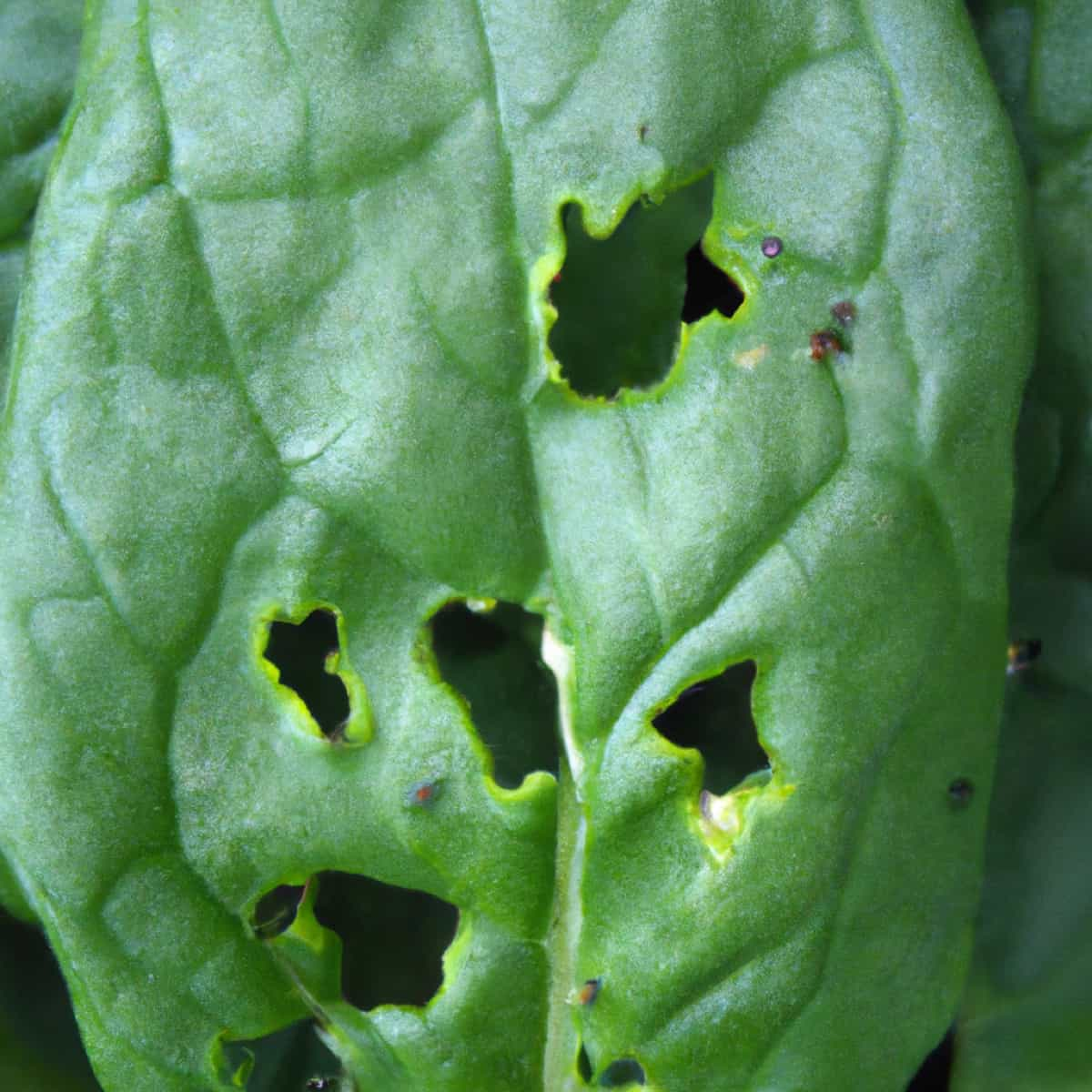Leaf miner is a common term used to describe various species of insects that feed on the tissue inside plant leaves, leaving visible trails or tunnels known as “mines.” Among them, the spinach leafminers are early-season pests that attack crops and weeds in the plant family Chenopodiaceae, which includes popular vegetables like chard, beets, and spinach.

These pests are small flies that lay eggs on the surface of leaves, and the larvae that hatch burrow inside the leaf tissue to feed and grow. While leaf miners may not directly kill plants, their damage can reduce yields and quality of crops, and severe infestations can lead to premature leaf drop and weaken the plant’s overall health.
Management of Leaf Miner in Spinach
The life cycle of Leaf Miner
The life cycle of the spinach leafminer begins with adult flies laying oblong white eggs in neat clusters on the underside of leaves. The eggs are less than 1 mm long and hatch in 3-6 days. The larvae which emerge from the eggs, known as maggots, burrow into the leaf tissue to feed and grow. The larvae may migrate from leaf to leaf down a row, causing damage to multiple plants. The larvae grow fully and drop into the soil to pupate in just a few weeks. However, they may also pupate inside the leaf.
The pupal stage lasts 10-12 days, after which adult flies emerge, and the cycle begins again. The entire life cycle of the spinach and beet leafminer takes 30-40 days. There are three to four generations of leafminer per season. These generations overlap, causing continuous season-long damage to succession-planted crops such as spinach, beets, and chard. Mid-late May, late June, and mid-August are peak activity periods for leafminer. After August, pupae enter the overwintering phase and won’t emerge until spring, when the cycle starts anew.
Identification of Leaf Miner in Spinach Field
- Adult: Small fly less than 2 mm (0.08 in) in length with a wing length equal to or slightly longer than the body. Flies have yellow heads and grayish-to-black bodies with yellow markings on their underside. Wings are dark in color and are folded horizontally over the back when at rest.
- Egg: White or yellowish, oval, and 0.2-1.0 mm (0.01-0.04) in length.
- Larva: Legless maggot that can be transparent immediately after hatching, changing to white or cream, and yellowing with age. The body is oval or wedge-shaped, 2-3 mm (0.08-0.12 in) in length, with typically dark-colored mouthparts. Two spiracles (breathing tubes) are present at the posterior end.
- Pupa: The pupa is enclosed within the last larval exoskeleton forming a smooth puparium. Color ranges from golden or reddish to dark brown, and length ranges from 1.5-3.5 mm (0.06-0.14 in). Two spiracles (breathing tubes) are visible on the posterior end.
Damage Symptoms of Leaf Miner in Spinach Field
- Punctures from feeding and egg-laying appear as white stipples primarily on the upper surface of the leaf
- Punctures can allow bacterial and fungal diseases to enter the plant
- The larva causes major damage to the plant as it feeds and tunnels through the leaf’s mesophyll layer
- Resulting damage includes blisters, blotchy mines, or serpentine tunneling
- Frass (feces) may be visible within mines and can contaminate leaves intended for human consumption
- Heavy feeding damage can reduce photosynthesis, causing leaves to dry and drop
- Serious infestations usually occur late in the season and can affect large areas of the leaf
- In warm areas and greenhouse production, damage may be more severe.
In case you missed it: Yellow Leaf Disease Management in Sugarcane: Symptoms, Identification, Treatment, Chemical, Biological, Natural, and Organic Control

Management of Leaf Miner in Spinach by Cultural Method
- Check transplants for signs of leaf mines and white stippling before planting; destroy infested plants.
- Clip and destroy infested leaves to prevent larval development.
- Plant diverse crops in a location, as monoculture plantings can be more susceptible to infestations.
- Place a floating row cover (lightweight plant fabric) over plants to inhibit adult flies from entering and laying eggs. Secure edges and ends of fabric for better protection. Note that this method is only effective when planting into a site not previously infested with leafminer pupae.
- Avoid excessive levels of nitrogen fertilization, as this can increase leafminer infestations.
Management of Leaf Miner in Spinach by Biological Method
- Encourage natural predators such as ants, predatory wasps, and spiders to help suppress leafminer populations.
- Use parasitic wasps like Optus (Opius) dissitus, Solenotus intermedius, Diglyphus spp., and Chrysocharis spp. to control leafminer larvae.
- Avoid the repeated use of broad-spectrum insecticides that can kill beneficial predators and parasitoids.
- Consider releasing commercially available wasps such as Diglyphus isaea and Dacnusa sibirica in greenhouses as part of an integrated pest management program.
Management of Leaf Miner in Spinach by Chemical Method
- Chemical control is another method for managing leafminer in spinach. The primary target of insecticides is the sap-feeding larva, which is protected within the leaf. Therefore, insecticides that penetrate the leaf tissue (translaminar activity) are the most effective. Adjuvants and surfactants can also increase the adherence of insecticides to the leaf tissue, improving their efficacy.
- Abamectin: abamectin (Agri-Mek) is a chemical recommendation (by chemical class) available for leafminer control in spinach.
Management of Leaf Miner in Spinach by Organic/Natural Method
- Spinosyns: spinosad [Success, Entrust (organic)] and spinetoram (Radiant) can be effective against leafminers in spinach. These products are derived from a naturally occurring soil bacterium. They are less toxic to beneficial insects than other chemical insecticides.
- Pyrethroids: gamma-cyhalothrin (Declare), lambda-cyhalothrin (Warrior), permethrin (Ambush, Pounce), and pyrethrin [Pyganic (organic)] are also effective against leafminer in spinach. Pyrethroids are derived from chrysanthemum flowers and can be an effective organic alternative to synthetic pyrethroids.
- Neem: Adadirachtin [Aza-Direct, Azatin (organic)] is an organic insecticide derived from the neem tree. It disrupts the feeding and growth of insect larvae, including leafminer.
- Insecticidal soap: M-Pede, Safer’s (organic) can be used to control leafminer in spinach. These soaps work by disrupting the outer cell membranes of insects, causing them to dehydrate and die.
- Oils: horticultural oil (many brands) and plant oils (peppermint, rosemary) (organic) can be used to control leafminer in spinach. These oils suffocate and dehydrate insects and are less harmful to beneficial insects than some chemical insecticides.
Preventive Measures for Control of Leaf Miner in Spinach Fields
- Remove known leafminer hosts, such as nightshade and dock weeds, and ornamental plants like chrysanthemum, marigold, dahlia, gerbera, and gypsophila from the vicinity of vegetable gardens and fields.
- Deeply plow crop residues and remove plants immediately after the final harvest to remove food sources and inhibit pupal development.
- Rotate crop plantings to reduce the buildup of leafminer populations in the soil.
- Use adequate irrigation to keep plants healthy and reduce stress, which can make them more susceptible to leafminer damage.
In case you missed it: Septoria Leaf Spot Management in Tomato: Symptoms, Treatment, Chemical, Biological, Natural, and Organic Control

Conclusion
Leaf miners can be a significant problem in spinach fields, causing damage to the plants and reducing yield and quality. They are difficult to control using conventional insecticides, as their life cycle occurs within the leaf tissue. However, several methods for managing leaf miners in spinach fields use organic and biological means. These include removing host plants, rotating crops, and using biological control agents such as parasitic wasps and generalist predators.
Preventive measures such as deep plowing and adequate irrigation can also help reduce infestations. Identifying leaf miners is essential for effective management. Growers should know the signs of damage caused by adult flies, larvae, and pupae. By combining these methods and adopting integrated pest management practices, growers can effectively manage leaf miners in spinach fields while reducing the use of harmful chemicals and preserving the environment.
- Deworming Schedule for Dogs/Puppies: A Beginners Guide
- How to Prevent and Control Parasites in Goats
- Beneficial Insects in Pest Management
- Natural Solutions for Pest Control in Flower Gardens
- Types of Fungicides Used in Agriculture
- Common Issues in the Fruit Development Stage of Pomegranate Farming
- Fruit Development Issues in Papaya: Easy Solutions and Treatment
- Soil-Borne Diseases and How to Protect Your Plants
- Practices to Prevent Disease Spread in the Garden